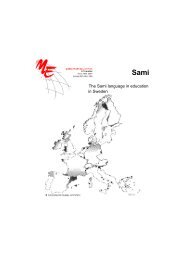Multilingual Early Language Transmission (MELT) - Mercator ...
Multilingual Early Language Transmission (MELT) - Mercator ...
Multilingual Early Language Transmission (MELT) - Mercator ...
Create successful ePaper yourself
Turn your PDF publications into a flip-book with our unique Google optimized e-Paper software.
exclude the increasing social class differences, religious issues or bullying due to disability as<br />
an important part of the program. Particularly the themes of multilingualism and<br />
multicultural education is tied to a social justice perspective. In Finland, as a Nordic welfare<br />
state, it is important that early childhood education is a socially just education. Many recent<br />
studies also have found that there is a fair amount of bullying in daycare and in schools in<br />
Finland (Stoor-Grenner & Kirves, 2011). Therefore fostering an accepting or a cosmopolitan<br />
attitude towards others is important. Our long term goal is that this teacher education<br />
program will contribute to decreasing prejudice and discrimination as well as marginalization<br />
of young people.<br />
The early childhood teachers need to have an understanding of the whole spectrum of<br />
diversity in Finland even if certain aspects or groups might not be represented in their<br />
daycare centers or preschools. Today most of the population has a limited and often<br />
stereotypical view of the Samis and Romas. Most teachers do not have the historical<br />
understanding of the societal structures that are part of the reason that the Romas<br />
traditionally have not done well in schools. Even though the curriculum is supportive of<br />
these groups the multicultural curriculum is directed only to the Romas and Samis<br />
themselves and not to the rest of the population (Finnish National Board of Education 2004).<br />
Likewise a deep understanding of the educational issues related to students of immigrant<br />
background is also lacking. Teachers are often supportive on a rhetorical level but unwilling<br />
to adjust their own teaching to be culturally responsive (Mansikka & Holm, 2010; Talib,<br />
2005).<br />
The third theme arts education consists of children’s culture, creative work as well as selfexpression<br />
and cooperation. These three areas are intended to foster children’s imagination<br />
and creativity as well as learning to enjoy the arts. We want to emphasize the arts as a<br />
contrast to the increasing focus on academic aspects of early childhood education. Our aim<br />
is to see the whole child in accordance with the official guidelines (Ministry of Social Affairs<br />
and Health, 2002).<br />
The importance of minority language university education<br />
To be a teacher requires solid knowledge of one’s own language, how language develops<br />
and research about bilingualism in order to be able to further mono- and bilingual children’s<br />
language development and skills. This is one of the main reasons why we have developed<br />
this new program. It was very difficult for the Swedish speaking high school students to be<br />
accepted to the highly competitive Finnish early childhood education program at the<br />
University of Helsinki and since the only Swedish speaking program was located far away<br />
there was a severe shortage of qualified early childhood education teachers in the<br />
metropolitan Helsinki region. The lack of qualified teachers was not only bad for the Swedish<br />
speaking children who have the right to daycare and schooling in Swedish but also meant<br />
that there was a high risk that bilingual parents would withdraw their children from the<br />
Swedish speaking daycare centers and pre-schools. In addition it is important for the preservice<br />
teachers to attend a Swedish speaking program in order to get a solid grasp of the<br />
Swedish speakers’ cultural knowledge. In a Finnish program they would of course get the<br />
Finnish cultural knowledge. Hence for the survival of Swedish children’s culture such as<br />
songs, riddles and stories a program in Swedish is needed. More subtle aspects such as<br />
values, customs and ways of interaction are also slightly different and important for the<br />
117



